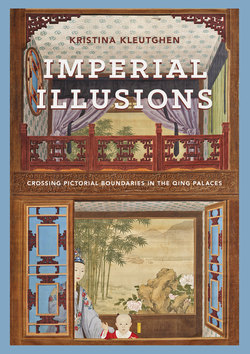Читать книгу Imperial Illusions - Kristina Kleutghen - Страница 54
На сайте Литреса книга снята с продажи.
Оглавлениеconcentration of highly intelligent Han literati in order to bolster support in this very prosperous and powerful region, as well as to balance the Manchu political presence at court. After his Second Southern Tour in 1689, Wang Hui was appointed to direct a massive project to produce twelve monumental horizontal scrolls, the Southern Tour Paintings (Nanxuntu), depicting the most significant geographic areas and events of the journey.70 By giving the empire’s preeminent artist the first major Qing imperial commission, Kangxi appropriated Wang’s own Great Synthesis of historical painting styles, grounded in the literati lineage and ideals, as the foundation for the official Qing court painting style. Wang painted the all-important landscape that framed the tour in his trademark synthetic style, literally setting the events of the tour within the literati landscape, and directed trained professional painters in incorporating elements of detailed academic realism derived from Song pictorial and stylistic models in order to represent the diversity of architecture and figures.71 By appropriating the style that defined Chinese painting at the time, as well as the realism those literati often criticized, Kangxi patronized a syncretic style that unified all these divergent elements as part of the Qing imperial agenda.
As Wang Hui was completing the massive Southern Tour project, Kangxi also made the decision to appropriate European representational modes, although it is important to note that not all European painting found imperial acceptance. During his first meeting with Kangxi in 1690, Giandomenico Gabiani (Bi Jia, 1623–94), the Jesuit vice-provincial of China, presented the emperor with a repeater clock, a barometer, a thermometer, and a miniature of the Holy Mother. Kangxi kept the instruments, but returned the painting. Rather than a demonstration of anti-Catholic feeling, however, this public gesture reflected his targeted interest in how the Jesuits, their knowledge, and their objects could serve him—whereas Christianity did not.72 To the great disappointment of the Jesuits, Kangxi was unconcerned with Western religion, but deeply interested in the political potential of European representational styles and techniques. The first such commission occurred with Jiao Bingzhen (c. 1660–1726), a painter and the supervisor of the Five Offices (wuguanzheng) at the imperial astronomical observatory, where he may have learned perspective from Verbiest. In 1696 Jiao became the first Qing court retainer to work in European pictorial techniques under imperial sanction when he incorporated them into the Imperially Composed Pictures of Tilling and Weaving (Yuzhi gengzhitu, figure 1.7). Jiao initially created a unique album of paintings inspired by a Southern Song handscroll,73 but Kangxi so approved of Jiao’s album that he ordered it replicated in an album of woodblock prints to be distributed throughout the empire. The images depict various scenes in the processes of rice cultivation and sericulture, illustrating the technological practicalities of producing rice and silk (activities gendered male and female, respectively), and therefore also illustrating a well-ordered Chinese society. The illustrations are accompanied by an imperial preface as well as individual poems that demonstrate Kangxi’s personal interest in these depictions of Qing subjects, nature, and productive technology, all flourishing under his rule in overt images of good governance.74
